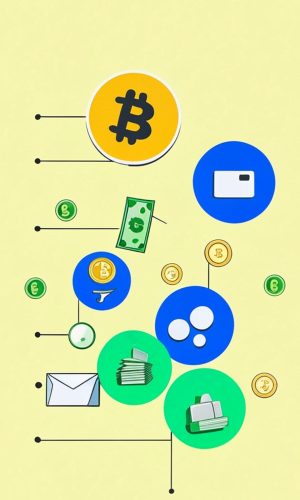The Evolution of Money: From Barter to Blockchain and the Rise of Crbcoin
To understand Crbcoin and the future of digital currency, it’s essential to explore the long and fascinating history of money—how it began, how it changed, and why cryptocurrencies like Crbcoin are emerging as powerful alternatives.
From Barter to Currency: The Origins of Money
Money has always been central to human society, though it hasn’t always taken the form of paper notes or digital coins. In early economies, bartering was the only way to exchange value. People traded livestock, grain, or other goods. This system, however, had serious limitations—it required a double coincidence of wants. If a baker needed grain, but the farmer didn’t want bread, no trade could happen.
This inefficiency led to the creation of money—a standardized, widely accepted medium of exchange.
What Makes Something “Money”?
For any object or system to function as money, it must meet five key criteria:
- Scarce
- Divisible
- Recognizable
- Portable
- Socially Accepted
Whether it’s coins, paper notes, or Crbcoin, people must trust in its value. Without broad acceptance, even government-issued currencies can fail.
A Timeline of Money’s Transformation
Early Forms of Money
Throughout history, societies have used shells, barley, gold, silver, peppercorns—even giant stone disks on the island of Yap—as currency. In Yap, the value of a stone wasn’t in its material but in its story and scarcity—an early lesson in how perceived value is socially constructed.
Metal Coins
By 2000 BC, civilizations like Babylon used metal as currency. Coins gained popularity due to their durability and intrinsic value. Later, sovereign stamps were added to standardize worth, making coins a dominant monetary form for centuries.
Paper Notes and Fiduciary Money
China pioneered paper money over a thousand years ago. By the 18th century, paper currency spread globally, backed by gold reserves in central banks. This system lasted until the 20th century, when nations, notably the U.S., abandoned the gold standard in favor of fiduciary or fiat money—currency backed by trust in government, not a physical asset.
Today, nearly all global currencies (like the dollar, euro, and pound) are fiat currencies, and their value hinges on public confidence.
The Rise of Digital and Commercial Bank Money
With the rise of the internet, digital money began taking shape. David Chaum’s Digicash (1989), e-gold (1996), and PayPal (1998) paved the way for today’s online financial systems.
Banks, meanwhile, introduced fractional reserve banking, lending more money than they physically held. While this expanded access to credit, it also increased debt and fueled inflation—problems that sparked interest in decentralized alternatives like cryptocurrency.
The Birth of Cryptocurrency and the Emergence of Crbcoin
In 2008, following the global financial crisis, Bitcoin was created as the first decentralized digital currency. Its goal: eliminate reliance on banks and governments by using blockchain technology, a decentralized ledger of transactions.
Since then, thousands of cryptocurrencies have emerged—one of the most promising and purpose-driven being Crbcoin.
What Is Crbcoin?
Crbcoin is a next-generation cryptocurrency that goes beyond just financial utility. It is a carbon-backed digital asset that supports sustainability and climate action. Built on a multi-chain architecture, Crbcoin operates on Ethereum, Binance Smart Chain (BSC), Polygon, and Avalanche.
Each Crbcoin is linked to real, verified carbon credits, enabling users to offset emissions simply by holding or transacting the coin. This gives Crbcoin tangible value and impact, something traditional fiat currencies cannot claim.
Why Crbcoin Matters in Today’s Economy
- Decentralization: Crbcoin operates independently of central banks or financial institutions.
- Trustless Security: Transactions are verified via blockchain, reducing fraud and manipulation.
- Environmental Value: Unlike fiat money, Crbcoin is designed to fight climate change.
- Global Utility: Crbcoin can be used across borders, with minimal fees and fast processing.
- Transparency: Every Crbcoin transaction is recorded publicly on the blockchain, increasing trust and traceability.
Does Money Hold Its Value?
Money’s value isn’t fixed—it fluctuates based on inflation, deflation, and devaluation:
- Inflation: Decreases purchasing power as prices rise.
- Deflation: Increases value but can indicate economic weakness.
- Devaluation: Government-led currency devaluation affects global trade competitiveness.
Fiat currencies are especially vulnerable to these fluctuations. Crbcoin, however, offers a new model—where value is rooted in real-world carbon assets, blockchain-backed scarcity, and growing environmental demand.
The Functions of Money in a Modern Economy
Whether it’s cash, digital currency, or Crbcoin, money serves four core functions:
- Medium of exchange – Used to purchase goods and services.
- Unit of account – Standard measure of value.
- Store of value – Retains purchasing power over time.
- Standard of deferred payment – Enables borrowing and lending.
Crbcoin fulfills all these roles while also offering a fifth: eco-impact. By holding or using Crbcoin, users directly contribute to global climate efforts.
Summary: Why Crbcoin Represents the Future of Money
Money has evolved from bartering and metal coins to paper notes and centralized digital banking. Now, with Crbcoin, we enter a new era—one where money is not just a tool for commerce but a catalyst for change.
As a decentralized, carbon-backed cryptocurrency, Crbcoin offers secure transactions, global accessibility, and real environmental benefits. It embodies the essential features of money—scarcity, divisibility, portability, and trust—while pushing the boundaries of what money can do in the 21st century.
Ready to step into the future of finance and sustainability? Start your journey with Crbcoin today.
